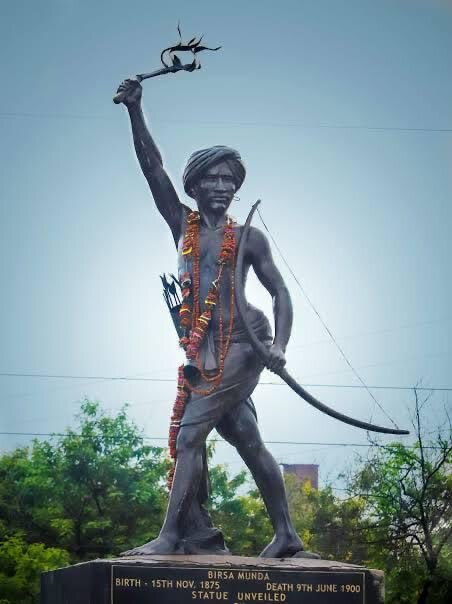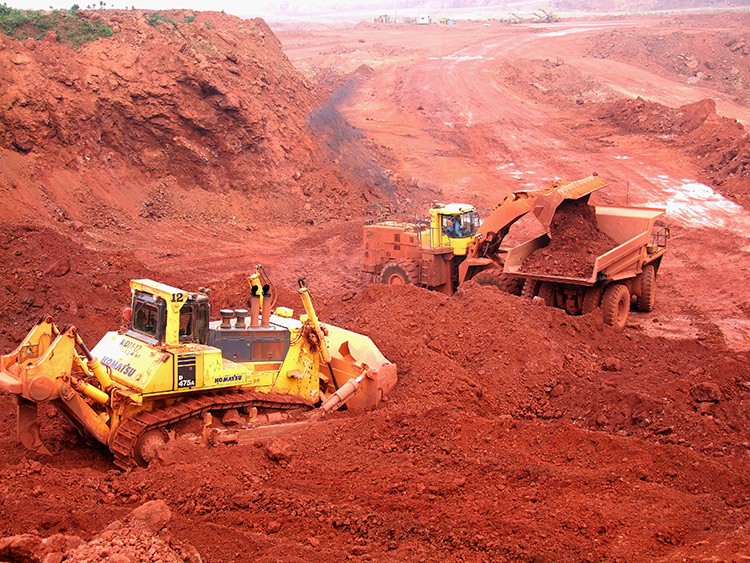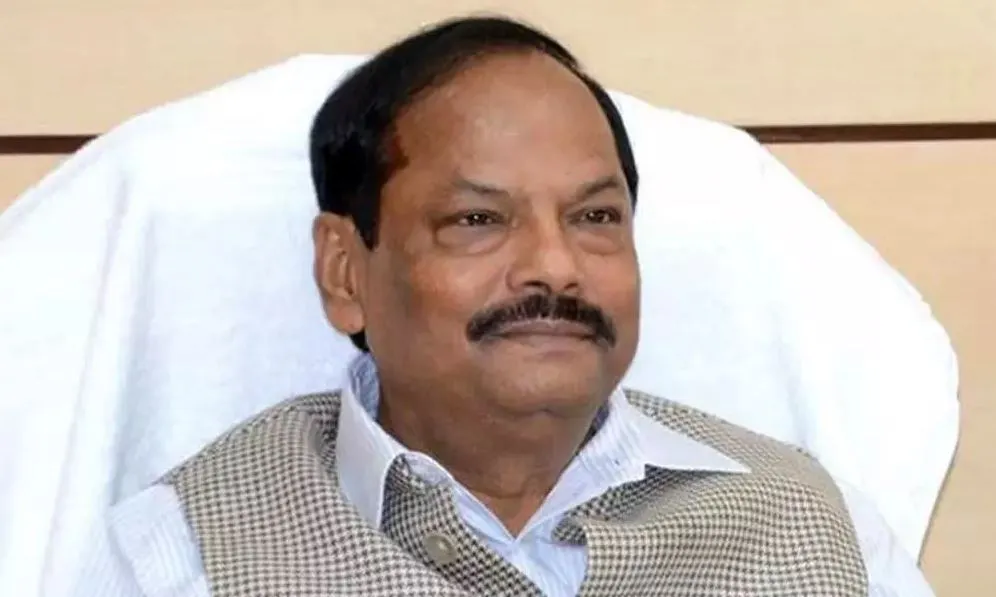JHARKHAND IN 17TH CENTURY
The present structure of the Palamau Fort was built in the 17th century CE. Daud Khan started his invasion from Patna on 3 April 1660. He attacked the southern part of Gaya district and reached the Palamau forts on 9 December 1660. Khan demanded that the Cheros convert to Islam and pay tribute, but the Cheros refused. This led to a series of attacks on the forts by Khan. The Cheros defended bravely but eventually lost and fled to the forests. The Mughal forces destroyed the temples and established Mughal rule over the region.
In 1765, the British East India Company took control of the region. This happened when Gopal Rai, the nephew of Chitrajeet Rai, betrayed him and helped the British attack the fort. On 28 January 1771, Captain Camac attacked the new fort. The Chero soldiers fought bravely but had to retreat to the old fort due to a lack of water. This allowed the British to take over the new fort without much resistance. The British then attacked the old fort with cannons, and despite strong resistance from the Cheros, the fort was besieged on 19 March 1771 and finally taken over by the British in 1772. The regions of Nagvansh and Ramgarh also became part of British rule.
The Kharagdiha kingdom was founded in the 15th century by the Vishnuvridhi Bhumihars, who gained the support of the ghatwals (local leaders) of Kharagdiha. After the Treaty of Allahabad, the British East India Company took control of this region, reducing the size of the kingdom. In 1809, the rulers of Kharagdiha became the Rajas of Dhanwar. The Kharagdiha gadis (small chiefdoms) were turned into zamindari estates (landholdings) by the British. Koderma, Gadi Palganj, and Ledo Gadi were some of the important zamindari estates.
Other princely states in the Chota Nagpur Plateau were influenced by the Maratha Empire but became tributary states of the British East India Company after the Anglo-Maratha Wars. These states were known as the Chota Nagpur Tributary States.
Early History and Tribal Identity

The region of present-day Jharkhand has been inhabited by various tribal communities such as the Santhal, Munda, Ho, Oraon, Kharia, and Bhumij for centuries.The land was rich in forests, minerals, and rivers, which supported the tribal way of life based on hunting, gathering, and shifting agriculture.These tribes had their own distinct social, political, and religious systems, which were different from the mainstream Hindu and Islamic cultures.
British Colonial Rule and Exploitation
The British East India Company established control over the region in the late 18th century after defeating local rulers like the Nagvanshis and the Cheros.The British imposed heavy taxes on land and introduced the zamindari (landlord) system, which displaced many tribal farmers. The discovery of coal and other minerals in the region led to increased mining activity, which further displaced the local communities and exploited their labor.
Tribal Resistance and Revolts
Tilka Manjhi Rebellion (1784–1785)
Tilka Manjhi, a Santhal leader, led the first armed revolt against British oppression. He attacked the British forces in Bhagalpur and organized the tribal communities to resist British land policies. The British captured and executed Tilka Manjhi, but his revolt inspired future resistance.

Kol Rebellion (1831–1832)
The Kols, under the leadership of Budhu Bhagat, rebelled against the British for taking away their lands and destroying their social system. The rebellion was violently suppressed by the British, but it highlighted the growing resentment among the tribes.

Santhal Rebellion (1855–1856)
The Santhal Rebellion was led by Sidhu and Kanhu Murmu against the British and oppressive landlords. The Santhals declared independence from British rule and attacked government offices and symbols of British authority. The British responded with brutal force, killing thousands of Santhals and crushing the rebellion.
Birsa Munda Movement (1895–1900)
Birsa Munda, known as “Bhagwan Birsa,” led the Ulgulan (Great Tumult) against British land policies and the Christian missionaries’ attempts to convert the tribal people. Birsa Munda preached social reforms and called for a return to the traditional Munda way of life. He organized guerrilla warfare against the British, but was captured and died in prison in 1900 at the young age of 25. His movement left a deep impact on the tribal consciousness and became a symbol of tribal pride and resistance.
Formation of Jharkhand Movement (Post-Independence)
After India gained independence in 1947, the tribal people of Jharkhand continued to face issues such as displacement due to mining and industrial projects, poor governance, and loss of cultural identity.

Jharkhand Party Formation (1950s)
The demand for a separate state of Jharkhand began in the early 1950s when Jaipal Singh Munda, a former tribal hockey player and leader, founded the Jharkhand Party.Jaipal Singh argued that the tribal regions of Bihar, Odisha, Madhya Pradesh, and West Bengal should be united into a separate state called Jharkhand.Although the party gained support in tribal areas, the demand was rejected by the central government
Rise of the Jharkhand Movement (1970s–1980s)
The Jharkhand movement gained momentum in the 1970s and 1980s under the leadership of organizations like the Jharkhand Mukti Morcha (JMM), led by Shibu Soren. The movement focused on issues like land rights, protection of tribal culture, and political autonomy. Protests, strikes, and political campaigns were held to press for the creation of Jharkhand.
Political and Legal Struggles (1990s)
In the 1990s, the demand for a separate Jharkhand state intensified. In 1995, the Bihar Legislative Assembly passed a resolution in support of the creation of Jharkhand. After years of political pressure and tribal unrest, the Indian government agreed to the formation of a new state.
Formation of Jharkhand (2000)
On 15 November 2000, on the birth anniversary of Birsa Munda, Jharkhand was officially carved out of Bihar and became the 28th state of India. Ranchi was declared the capital of Jharkhand, and Babulal Marandi became the first Chief Minister.
Post-Formation Challenges and Progress
After its formation, Jharkhand faced several challenges:– Political instability and corruption slowed down development. Naxalite (Maoist) insurgency in forest areas affected law and order. Despite being rich in minerals, the benefits of mining have not fully reached the local population. Tribal identity and land rights remain key issues in the state.
Jharkhand has also seen progress:
Industrial and mining development has created jobs and improved infrastructure. The state has witnessed growth in education, healthcare, and tourism. Tribal culture and festivals like Sarhul and Karma have gained recognition at the national level.

Legacy of the Jharkhand Movement
The struggle for Jharkhand is remembered as a symbol of tribal resistance and cultural identity. The contributions of leaders like Tilka Manjhi, Sidhu and Kanhu Murmu, Birsa Munda, and Shibu Soren are celebrated across the state. Birsa Munda is honored as a national hero, and his message of tribal unity and resistance continues to inspire generations.
JHARKHAND AFTER (2000)

Jharkhand became the 28th state of India on 15th November 2000, after being separated from Bihar. The state was formed on the birth anniversary of Birsa Munda, a tribal freedom fighter. Since its formation, Jharkhand has witnessed significant political, social, and economic developments. when it was carved out from Bihar, marking the realization of long-standing demands by the region’s tribal communities for a separate state. The state’s formation was driven by the desire to address the economic, social, and political neglect of the indigenous population, which had been marginalized and exploited due to the region’s rich natural resources, including coal, iron ore, and bauxite. Despite its resource wealth, Jharkhand faced significant challenges in terms of infrastructure, poverty, education, healthcare, and industrial development. The tribals, whose lands were being acquired for mining and industrial projects, suffered displacement and loss of livelihood, leading to tensions between the government, industries, and local communities. The region had a long history of tribal uprisings, including the struggle led by Birsa Munda in the late 19th century, symbolizing resistance to colonial exploitation, which became the foundation for the demand for statehood. Following its formation, Jharkhand experienced political instability, with frequent changes in leadership, but it was also a focal point of India’s Maoist insurgency, as many areas were heavily affected by Naxalite violence. The state’s governance has been marked by efforts to balance industrial growth with the welfare of its tribal population, with leaders like Shibu Soren and Babulal Marandi playing pivotal roles in the state’s early years. Over time, the political landscape was dominated by parties such as the Jharkhand Mukti Morcha (JMM) and the Bharatiya Janata Party (BJP), with the latter’s rise leading to significant policy shifts. Despite the rich natural resources, Jharkhand remains one of India’s poorer states, struggling with economic disparity,underdevelopment, and continuing tribal issues like land rights. While there have been efforts to improve infrastructure, education, and healthcare, the state continues to grapple with the complex challenges of fostering economic development without compromising the rights and well-being of its indigenous population.

Formation of Jharkhand (2000)
Historical Background Before 2000
-
Pre-independence Era: The area now known as Jharkhand was part of larger administrative regions like Bihar, Odisha, and Bengal. The tribes and indigenous groups of the region had their distinct cultures and histories.
-
Post-independence: After India gained independence in 1947, Jharkhand was still a part of Bihar. The people of the region, mainly tribals, began to voice their concerns about being politically and economically marginalized.
The Movement for a Separate State
Tribal Identity and Economic Marginalization: The movement for a separate state was primarily led by the indigenous tribal communities, who felt they were being neglected by the government of Bihar. They faced issues like land alienation, displacement due to mining, and lack of development in education, health, and infrastructure.
Leaders of the Movement
Birsa Munda: A key tribal leader who led the Ulgulan or the Munda Rebellion in the late 19th century, symbolizing the tribal fight for land and rights.
Jharkhand Mukti Morcha (JMM): The most influential political party in the movement for a separate state, founded by Shibu Soren in 1972.
Other Leaders: Leaders like Babulal Marandi of the BJP and Adivasi (tribal) activists played a crucial role in pushing the cause.
Political and Administrative Struggles
Formation of the Jharkhand Mukti Morcha (JMM): The JMM, under Shibu Soren, became the focal point for the state’s creation. The party demanded a separate state for the tribal population, who had distinct cultural, social, and economic needs. Despite numerous protests and demands for autonomy, the demand for Jharkhand was often ignored or delayed by the government of Bihar, led at various times by different political parties like the Congress and Janata Dal.
The Birth of Jharkhand
The late 1990s saw significant political changes in Bihar, with increasing fragmentation and the rise of regional parties. Dissatisfaction with governance led to the emergence of parties focusing on local and caste-based issues. During this period, the demand for a separate state of Jharkhand gained strong momentum. The movement for Jharkhand had existed for decades, primarily led by tribal leaders who felt culturally and politically marginalized under Bihar’s administration. The region was rich in natural resources, yet its local population did not benefit significantly, leading to resentment. Political parties like the Jharkhand Mukti Morcha (JMM) mobilized people through protests and rallies, emphasizing economic exploitation and lack of representation. National parties also responded to the growing demand. The Bharatiya Janata Party (BJP), under Atal Bihari Vajpayee’s leadership, supported the cause, making it part of their political agenda. After years of struggle, Jharkhand was finally carved out of Bihar in 2000.The late 1990s was a crucial phase in Bihar’s history, as the rise of regional politics and the success of the Jharkhand movement reshaped the political landscape, highlighting the importance of regional aspirations in India’s democratic system.
Agreements and Movements
After years of protests, strikes, and negotiations, the Bihar Reorganization Act, 2000, was passed by the Indian Parliament. This act led to the creation of Jharkhand as a separate state.On November 15, 2000, Jharkhand officially became the 28th state of India, with Ranchi as its capital. November 15 was chosen as the date because it marks the birth anniversary of Birsa Munda, a legendary tribal freedom fighter who symbolized the struggle for tribal rights in the region.
First Government of Jharkhand

Babulal Marandi: The first Chief Minister of Jharkhand was Babulal Marandi, a leader from the BJP. He took office on November 15, 2000, the day the state was formed.
Babulal Marandi, Jharkhand’s first Chief Minister, faced multiple challenges in establishing a stable government after the state’s creation in 2000. Building governance structures from scratch was a major task, along with addressing demands for tribal rights and equitable development. Regional disparities between tribal and non-tribal areas led to social and political tensions. Additionally, law and order remained a pressing issue, as the growing Maoist insurgency posed a serious threat to stability. Marandi’s government had to balance economic development with security concerns while ensuring that marginalized communities received proper representation and benefits from Jharkhand’s rich natural resources.
Economic and Social Challenges After Formation
Jharkhand is one of India’s most resource-rich states, abundant in minerals such as coal, iron ore, and bauxite. However, despite this wealth, the state has remained economically backward. A major reason for this paradox is that the control and profits from these resources are largely held by private companies and central government agencies, leaving little direct benefit for the local population, particularly tribal communities.
The mining industry has led to displacement, environmental degradation, and loss of traditional livelihoods for many indigenous people. While industries extract vast mineral wealth, the region suffers from poor infrastructure, unemployment, and inadequate social services. The lack of proper policies to ensure resource-sharing with local communities has fueled resentment and social unrest.
Additionally, corruption, bureaucratic inefficiencies, and weak governance have further hindered economic development. Addressing these challenges requires policies focused on inclusive growth, sustainable mining practices, and equitable distribution of economic benefits to uplift Jharkhand’s marginalized communities.




Tribal Rights
After Jharkhand was formed in 2000, Protecting tribal rights, especially land ownership, became a major challenge. The state’s rich mineral reserves attracted large-scale mining and industrial projects, often leading to land acquisition that displaced indigenous communities. Despite legal protections like the Chotanagpur Tenancy Act (CNT) and the Santhal Parganas Tenancy Act (SPT), violations were frequent, and corporate interests often overpowered tribal rights. Many communities resisted displacement, leading to protests and conflicts. The struggle for land rights became a key political and social issue, highlighting the need for stronger enforcement of protective laws and more inclusive development policies.
Political Developments in the 2000s
Instability: The early years of Jharkhand were marked by political instability. The state saw frequent changes in government and leadership. This was due to the fractious political landscape and coalition politics.

Shibu Soren’s Role: In 2005, Shibu Soren, a key leader of the Jharkhand Mukti Morcha (JMM), became the Chief Minister of Jharkhand. His appointment was historically significant as he had been a central figure in the decades-long struggle for the state’s formation. As a tribal leader, Soren’s rise to power was seen as a victory for the indigenous communities who had long fought for their rights and representation. However, his tenure was short-lived due to political instability and governance challenges.
Soren’s government faced difficulties in maintaining a stable coalition, as Jharkhand’s political landscape was deeply fragmented. The state witnessed frequent power struggles, with shifting alliances among parties like the Bharatiya Janata Party (BJP), the Indian National Congress, and regional groups. These conflicts weakened governance and hindered long-term development planning.
Moreover, issues such as corruption, poor administration, and growing Maoist insurgency added to the instability. Soren’s brief tenure ended within months as he failed to prove his majority in the assembly. This marked the beginning of a period of frequent leadership changes, making Jharkhand one of India’s most politically unstable states. The continued political turbulence slowed economic progress and delayed the resolution of key issues like land rights and tribal welfare.
Babulal Marandi (2000-2003, BJP)

Babulal Marandi, Jharkhand’s first Chief Minister (2000-2003), prioritized infrastructure development, including roads and power projects. However, internal disputes within the BJP, particularly growing dissent among party leaders and coalition pressures, led to his resignation. Political differences and leadership challenges ultimately forced him to step down, making way for Arjun Munda.
Arjun Munda (2003-2006, BJP)

Arjun Munda, serving as Jharkhand’s Chief Minister (2003-2006) from the BJP, focused on tribal welfare and industrialization. His tenure saw efforts to boost infrastructure and economic growth. However, in 2006, his government lost power when the Jharkhand Mukti Morcha (JMM) withdrew support, leading to political instability and his resignation.
Madhu Koda (2006-2008, Independent)

Madhu Koda became Jharkhand’s first independent Chief Minister in 2006 with support from Congress and JMM. His tenure focused on governance but was overshadowed by corruption allegations. Accused of massive financial irregularities, he lost political backing and was removed from office in 2008, later facing legal proceedings.
Shibu Soren (2008-2009, JMM)

Shibu Soren became Jharkhand’s Chief Minister in 2008 with support from allies. However, he failed to secure a majority in the assembly after losing a crucial by-election. Lacking the necessary numbers, his government collapsed, forcing him to resign in 2009, marking another phase of political instability in the state.
President’s Rule (Jan 2009 - July 2009)
Shibu Soren’s failure to prove his majority in the assembly, Jharkhand plunged into political instability. As no party or coalition could form a stable government, the state was placed under President’s Rule from January 2009 to July 2009. During this period, the legislative assembly was kept in suspended animation, and the administration was directly handled by the Governor under the central government’s supervision. The move aimed to ensure governance and maintain law and order until a new government could be formed. President’s Rule was lifted in July 2009 when political conditions improved, paving the way for fresh leadership.
Arjun Munda (2010-2013, BJP)
Arjun Munda became Jharkhand’s Chief Minister in 2010, leading a coalition government with the BJP, JMM, and AJSU. His tenure focused on governance and development, but political tensions grew over leadership issues. In 2013, the JMM withdrew support, causing the government to collapse. Unable to prove a majority, Munda resigned, leading to President’s Rule again.
Raghubar Das (2014-2019, BJP)

In the 2014 elections, the BJP secured a majority, making Raghubar Das the first non-tribal Chief Minister of Jharkhand. His tenure emphasized infrastructure, improving roads, electricity access, and boosting industrial development. However, dissatisfaction over land and employment policies grew. In the 2019 elections, he lost to the JMM-Congress-RJD alliance, leading to a change in leadership.
Hemant Soren (2019-2024, JMM)

Hemant Soren became Jharkhand’s Chief Minister in 2019 after the JMM-Congress-RJD alliance won the elections. His tenure prioritized farmers’ welfare, tribal rights, and social justice. He launched schemes to provide financial aid to farmers and improve healthcare and education for marginalized communities. Soren also introduced policies to regulate mining activities, ensuring better environmental protection and benefits for local populations. His government worked towards strengthening tribal empowerment by safeguarding land rights and promoting traditional livelihoods. Despite his efforts, his tenure faced political challenges and legal controversies, impacting governance. His leadership aimed at inclusive development while addressing the state’s socio-economic issues.
Challenges of Statehood
Economic Development: Despite being rich in minerals, Jharkhand has remained one of India’s most underdeveloped states. Poverty is widespread, particularly among tribal communities, who struggle with unemployment and lack of economic opportunities. Illiteracy remains high due to inadequate educational infrastructure, especially in rural areas. The state’s healthcare system is weak, with limited access to medical facilities, resulting in poor health indicators. Additionally, large-scale displacement due to mining and industrial projects has worsened the situation, leaving many without land or livelihoods. Corruption, governance issues, and political instability have further hindered development, making it difficult to address these long-standing social and economic challenges.
Industrialization vs. Tribal Rights: Industrialization in Jharkhand has played a crucial role in economic growth, driven by the state’s abundant natural resources such as coal, iron ore, and bauxite. Large mining and industrial projects have attracted significant investment, generating employment opportunities and contributing to infrastructure development. However, this growth has come at a heavy cost, particularly for the tribal communities who have traditionally lived on the lands where these industries operate.
The expansion of mining and industrial projects has led to large-scale land acquisition, often displacing indigenous populations. While compensation and rehabilitation schemes exist, they have frequently been inadequate or poorly implemented, leaving many displaced families struggling without proper livelihoods or resettlement support. The loss of ancestral land not only affects economic stability but also disrupts cultural and social structures, deepening the resentment among tribal communities.
This situation has created ongoing tensions between the state government, industries, and tribal populations. While the government promotes industrialization as a means of development, many indigenous groups view it as a threat to their existence. Protests, legal battles, and conflicts over land rights have become common, slowing industrial progress and highlighting the need for a more inclusive development approach that ensures fair compensation and safeguards tribal rights.
Recent Developments
During the 2010s, Jharkhand experienced significant political shifts, with power alternating between the Bharatiya Janata Party (BJP) and the Jharkhand Mukti Morcha (JMM). In the 2019 elections, Hemant Soren of the JMM returned to power, forming an alliance with the Indian National Congress and other regional parties. His leadership marked a renewed focus on the state’s tribal identity and addressing longstanding issues faced by indigenous communities.


Focus on Tribal Welfare
Under Hemant Soren’s administration, several initiatives have been implemented to promote tribal welfare:
Educational Programs: The government launched schemes to improve educational access and quality in tribal regions, including scholarships and the establishment of new schools.
Healthcare Initiatives: Efforts have been made to enhance healthcare infrastructure in tribal areas, aiming to reduce disparities and improve health outcomes.
Economic Empowerment: Programs have been introduced to promote traditional crafts and skills, providing market access and financial support to tribal artisans.
Land Reforms
Addressing land rights has been a priority:
-
Land Ownership: The administration has worked to ensure that tribal communities have secure land ownership, implementing measures to prevent unlawful land acquisitions.
-
Land Restoration: Initiatives have been undertaken to return illegally acquired lands to their rightful tribal owners, reinforcing traditional land rights.
Combating Corruption
To enhance governance and public trust:
Transparency Measures: The government has implemented policies to increase transparency in administrative processes, reducing opportunities for corruption.
Anti-Corruption Agencies: Strengthening institutions tasked with investigating and prosecuting corrupt practices has been a focus, aiming to deter misconduct among public officials.
Developments
As of March 2025, Hemant Soren’s government continues to address challenges:
Economic Development: Efforts are ongoing to balance industrial growth with environmental conservation and the rights of tribal communities.
Social Programs: New social welfare programs targeting marginalized populations have been introduced to reduce poverty and inequality.
Infrastructure Projects: Investments in infrastructure aim to improve connectivity and access to essential services in remote areas.
These initiatives reflect a comprehensive approach to governance, striving to create an inclusive and equitable society in Jharkhand.
